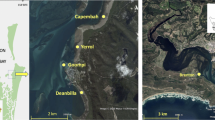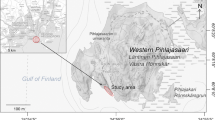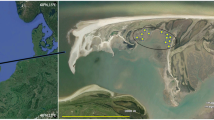Abstract
The sandy-bottom macrobenthic community of Mugu Lagoon, a relatively pristine southern California (USA) marine lagoon, demonstrated (1) nearly constant community composition over 37 months of observation, (2) relatively little temporal variability in the population densities of the most abundant species over 37 months, and (3) a pattern of depth stratification in which very little vertical overlap existed among the six most abundant species. The only two species whose vertical distributions overlapped broadly showed horizontal spatial segregation, each abundant in different areas within the sand habitat. These community characteristics imply the importance of biological factors in structuring the sand benthos. The relatively large volume required for living space by these macrofauna suggests that competition for space may be the biological factor most important in determining the observed temporal and spatial abundance patterns. The muddy-sand community and the mud community of Mugu Lagoon also revealed similar patterns of stratification: new abundant species replaced species at the same sedimentary level while not greatly affecting species populations at other non-overlapping levels. In the sand community of Tijuana Slough, two of the abundant species of Mugu Lagoon's sand community were nearly absent as an apparent result of human over-exploitation. Probably in response, densities of species living at the sedimentary levels normally occupied by the missing species were much higher than would be predicted if competition for space were unimportant. In field experiments, removal of the deposit feeder Callianassa californiensis resulted in high recruitment of Sanguinolaria nuttallii, whereas control areas showed no S. nuttallii recruitment. Experiments also suggest that negative intraspecific interactions between Cryptomya californica individuals may explain the observed rapid emigration from areas of artificially high density. Perhaps the relatively great environmental predictability of southern California lagoons has permitted competitive interactions to play a singnificant role in determining the temporal and spatial abundance patterns of the soft-bottom macrobenthos.
Similar content being viewed by others
Literature Cited
Aller, R.C. and R.E. Dodge: Animal-sediment relations in a tropical lagoon, Discovery Bay, Jamaica. J. mar. Res. 32, 209–232 (1974)
Blegvad, H.: Quantitative investigations of bottom invertebrates in the Limfjord 1910–1927 with special reference to plaice food. Rep. Dan. biol. Stn 34, 33–52 (1928)
Bloom, S.A., J.L. Simon and V.D. Hunter: Animal-sediment relations and community analysis of a Florida estuary. Mar. Biol. 13, 43–56 (1972)
Boesch, D.F., M.L. Wass and R.W. Virnstein: The dynamics of estuarine benthic communities. In: Estuarine processes. Vol. 1. Uses, stresses, and adaptation to the estuary, pp 177–196. Ed. by M. Wiley. New York: Academic Press 1976
Bradley, W.H. and P. Cooke: Living and ancient populations of the clam Gemma gemma in a Maine coast tidal flat. Fishery Bull. Fish Wildl. Serv. U.S. 58, 305–334 (1959)
Connell, J.H.: Effects of competition, predation by Thais lapillus and other factors on natural populations of the barnacle Balanus balanoides. Ecol. Monogr. 31, 61–104 (1961)
Dayton, P.K.: Competition, disturbance, and community organization: the provision and subsequent utilization of space in a rocky intertidal community. Ecol. Monogr. 41, 351–389 (1971)
Fager, E.W.: A sand-bottom community of invertebrates in shallow water. Limnol. Oceanogr. 13, 448–464 (1968)
Jackson, J.B.C.: The ecology of the molluscs of Thalassia communities, Jamaica, West Indies. II. Molluscan population variability along an environmental stress gradient. Mar. Biol. 14, 304–337 (1972)
Johnson, R.G.: Temperature variation in the infaunal environment of a sand flat. Limnol. Oceanogr. 10, 114–120 (1965)
—: Salinity of interstitial water in a sandy beach. Limnol. Oceanogr. 12, 1–7 (1967)
Levinton, J.S.: Stability and trophic structure in deposit-feeding and suspension-feeding communities. Am. Nat. 106, 472–486 (1972)
— and R.K. Bambach: A comparative study of Silurian and Recent deposit-feeding bivalve communities. Paleobiology 1, 97–124 (1975)
MacGinitie, G.E.: The natural history of Callianassa californiensis Dana. Am. Midl. Nat. 15, 166–177 (1934)
Naqvi, S.M.Z.: Effects of predation on infaunal invertebrates of Alligator Harbor, Florida. Gulf Res. Rep. 2, 313–321 (1968)
Paine, R.T.: Food web complexity and species diversity. Am. Nat. 100, 65–75 (1966)
Parker, R.H.: Macro-invertebrate assemblages as indicators of sedimentary environments in the east Mississippi delta region. Bull. Am. Ass. Petrol. Geol. 40, 295–376 (1956)
Peterson, C.H.: Species diversity, disturbance, and time in the bivalve communities of some coastal lagoons, 229 pp. Ph.D. thesis, University of California, Santa Barbara 1972
—: Stability of species and of community for the benthos of two lagoons. Ecology 56, 958–965 (1975)
—: Relative abundances of living and dead molluscs in two Californian lagoons. Lethaia 9, 137–148 (1976)
Rhoads, D.C. and D.K. Young: The influence of deposit-feeding organisms on sediment stability and community trophic structure. J. mar. Res. 28, 150–178 (1970)
Ronan, T.e., Jr.: Structural and paleoecological aspects of a modern marine soft-sediment community: an experimental field study, 220 pp. Ph.D. thesis, University of California, Davis 1975
Sanders, H.L.: Oceanography of Long Island Sound, 1952–1954. X. The biology of marine bottom communities. Bull. Bingham oceanogr. Coll. 15, 345–414 (1956)
—: Benthic studies in Buzzards Bay. I. Animalsediment relationships. Limnol. Oceanogr. 3, 245–258 (1958)
—: Benthic studies in Buzzards Bay. III. The structure of the soft-bottom community. Limnol. Oceanogr. 5, 138–153 (1960)
—: Marine benthic diversity: a comparative study. Am. Nat. 102, 243–282 (1968)
—: Benthic marine diversity and the stabilitytime hypothesis. Brookhaven Symp. Biol. 22, 71–81 (1969)
—, E.M. Goudsmit, E.L. Mills and G.E. Hampson: A study of the intertidal fauna of Barnstable Harbor, Massachusetts. Limnol. Oceanogr. 7, 63–79 (1962)
Timko, P.L.: Sand dollars as suspension feeders: a new description of feeding in Dendraster excentricus. Biol. Bull. mar. biol. Lab., Woods Hole 151, 247–259 (1976)
Turpaeva, E.P.: Feeding and trophic classification of benthic invertebrates. Trudy Inst. Okeanol. 7, 259–299 (1954)
Virnstein, R.W.: The effects of predation by epibenthic crabs and fishes on benthic infauna in Chesapeake Bay, 87 pp. Ph.D. thesis, College of William and Mary, Williamsburg 1976
Warme, J.E.: Paleoecological aspects of a modern coastal lagoon. Univ. Calif. Publs geol. Sci. 87, 1–131 (1971)
—, A.A. Ekdale, S.F. Ekdale and C.H. Peterson: Raw material of the fossil record. In: Structure and classification of paleocommunities, pp 143–169. Ed. by R.W. Scott and R.R. West. Stroudsburg, Pennsylvania: Dowden, Hutchinson, & Ross, Inc. 1976
Woodin, S.A.: Polychaete abundance patterns in a marine soft-sediment environment: the importance of biological interactions. Ecol. Monogr. 44, 171–187 (1974)
—: Adult-larval interactions in dense infaunal assemblages: patterns of abundance. J. mar. Res. 34, 25–41 (1976)
Young, D.K.: Effects of infauna on the sediment and seston of a subtidal environment. Vie Milieu (Suppl.) 22, 557–571 (1971)
—, M.A. Buzas and M.W. Young: Species densities of macrobenthos associated with seagrass: a field experimental study of predation. J. mar. Res. 34, 577–592 (1976)
Ziegelmeier, E.: Das Makrobenthos im Ostteil der Deutschen Bucht nach qualitativen und quantitativen Bodengreiferuntersuchungen in der Zeit von 1949–1960. Veröff. Inst. Meeresforsch. Bremerh. (Sonderband) 1, (3. meeresbiol. Symp.), 101–114 (1963)
—: Über Massenvorkommen verschiedener makrobenthaler Wirbelloser während der Wiederbesiedlungsphase nach Schädigungen durch “katastrophale” Umwelteinflüsse. Helgoländer wiss. Meeresunters. 21, 9–20 (1970)
Zobell, C.E.: Studies on the bacterial flora of marine bottom sediments. J. sedim. Petrol. 8, 10–18 (1938)
Author information
Authors and Affiliations
Additional information
Communicated by J. M. Lawrence, Tampa
Rights and permissions
About this article
Cite this article
Peterson, C.H. Competitive organization of the soft-bottom macrobenthic communities of southern California lagoons. Mar. Biol. 43, 343–359 (1977). https://doi.org/10.1007/BF00396928
Accepted:
Issue Date:
DOI: https://doi.org/10.1007/BF00396928




